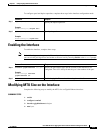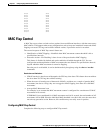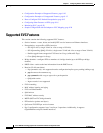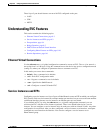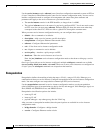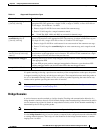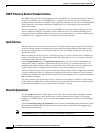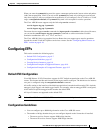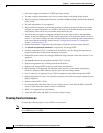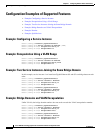
8-3
Cisco ASR 901 Series Aggregation Services Router Software Configuration Guide
OL-23826-09
Chapter 8 Configuring Ethernet Virtual Connections
Understanding EVC Features
These Layer 2 port-based features can run with EVC configured on the port:
• LACP
• CDP
• MSTP
Understanding EVC Features
This section contains the following topics:
• Ethernet Virtual Connections, page 8-3
• Service Instances and EFPs, page 8-3
• Encapsulation, page 8-4
• Bridge Domains, page 8-5
• DHCP Client on Switch Virtual Interface
• Configuring Other Features on EFPs, page 8-16
• Rewrite Operations, page 8-6
Ethernet Virtual Connections
Use the ethernet evc evc-id global configuration command to create an EVC. The evc-id or name is a
text string from 1 to 100 bytes. Using this command moves the device into service configuration mode
(config-srv) where you configure all parameters that are common to an EVC.
In this mode you can use these commands:
• default—Sets a command to its defaults
• exit—Exits EVC configuration mode
• no— Negates a command or sets its defaults
• oam—Specifies the OAM Protocol
• uni—Configures a count UNI under EVC
Service Instances and EFPs
Configuring a service instance on a Layer 2 port or EtherChannel creates an EFP on which you configure
EVC features. Each service instance has a unique number per interface, but you can use the same number
on different interfaces because service instances on different ports are not related.
If you defined an EVC by using the ethernet evc evc-id global configuration command, you can
associate the EVC with the service instance (optional). There is no default behavior for a service
instance. You can configure a service instance only on trunk ports with no allowed VLANs. Any other
configuration is not allowed. After you have configured a service instance on an interface, switchport
commands are not allowed on the interface. You can also configure a service instance on an
EtherChannel group.



